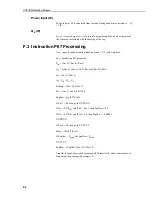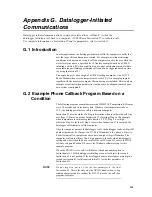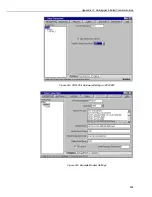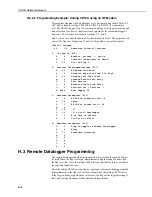
Appendix F. Dynagage Processing Instruction (P67)
F-3
Parameter 8
High Flow Filter (0.042cm s
-1
). This filter sets F equal to a calculated theoretical
maximum flow (F
max
) if F is greater than F
max
. F
max
equals the theoretical maximum
velocity (V
max
) multiplied by the cross sectional area of the stem
(F
max
= V
max
∗
A).
This filter is used to protect the integrity of the flow accumulator when F exceeds
the gauge capacity. When F is exceptionally high, nearly all of the heat is
absorbed by the sap. As F continues to increase, dT approaches zero
asymptotically. As dT becomes infinitesimal, previously insignificant thermal
noise from radiation or other sources can cause a major exaggeration of F. The
value 0.042cm s
-1
for V
max
was determined by Dynamax to be a typical maximum.
You have the option to increase or decrease the value of V
max
(Parameter 8) when
the species under study is verified to be accurately measured.
F.2.4 Instruction Output
Parameter 9
Two output options are available.
Option 0
Option 1
Sapflow (g h
-1
)
Sapflow (g h
-1
)
K
shapp
(W mV
-1
)
K
shapp
(W mV
-1
)
dT (°C)
power input (W)
Q
v
(Vertical Flux, W)
Q
r
(Radial Flux, W)
Q
f
(Sapflow Flux, W)
Sapflow (g h
-1
)
The calculated sap flow rate. If total sapflow is desired, Output Processing
Instruction 72 can be used in conjunction with Instruction 67 to totalize sap flow.
Qf and dT
Q
f
is the residual energy that is assumed lost through sap flow and is defined as:
Q
f
= Q
h
- (Q
r
+ Q
v
)
The temperature difference, dT, is defined as:
dT = Upper TC - Lower TC
where the Upper TC is the thermocouple above the heater and the Lower TC is the
thermocouple below the heater.
Q
r
, K
sh
, K
shapp
Qr, radial energy loss, is the loss of energy through the cork and foam sheath on
the sensor. K
sh
, the thermal conductivity constant, is used to calculate Q
r
. Since Q
r
can be a large percentage of the total energy loss, K
sh
must be determined
accurately as outlined in the Dynagage manual. The essence of the procedure is to
record K
sh
(the second output of Instruction 67, K
shapp
) when there is no stem flow
such as at dawn. This value is then placed in Instruction 67, Parameter 2, K
sh
(W
mV
-1
). K
shapp
and K
sh
(W mV
-1
) have no effect on each other in Instruction 67. K
sh
must be determined for each installation.
















































